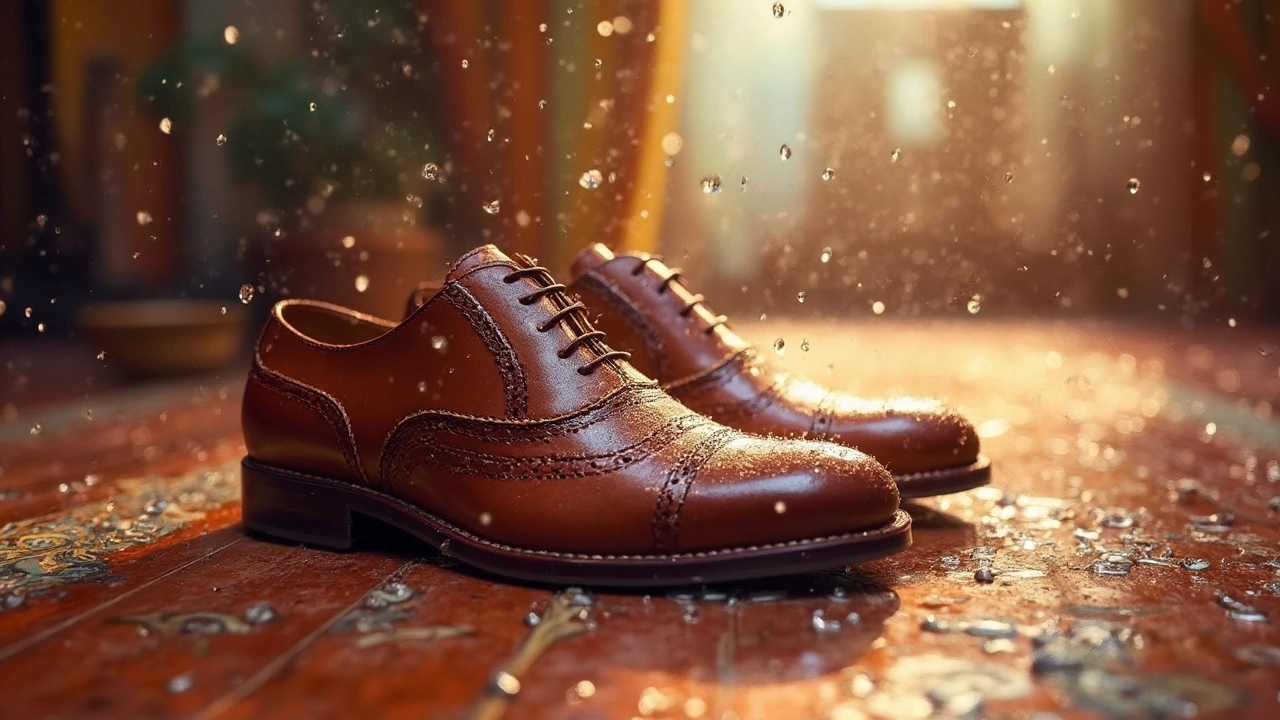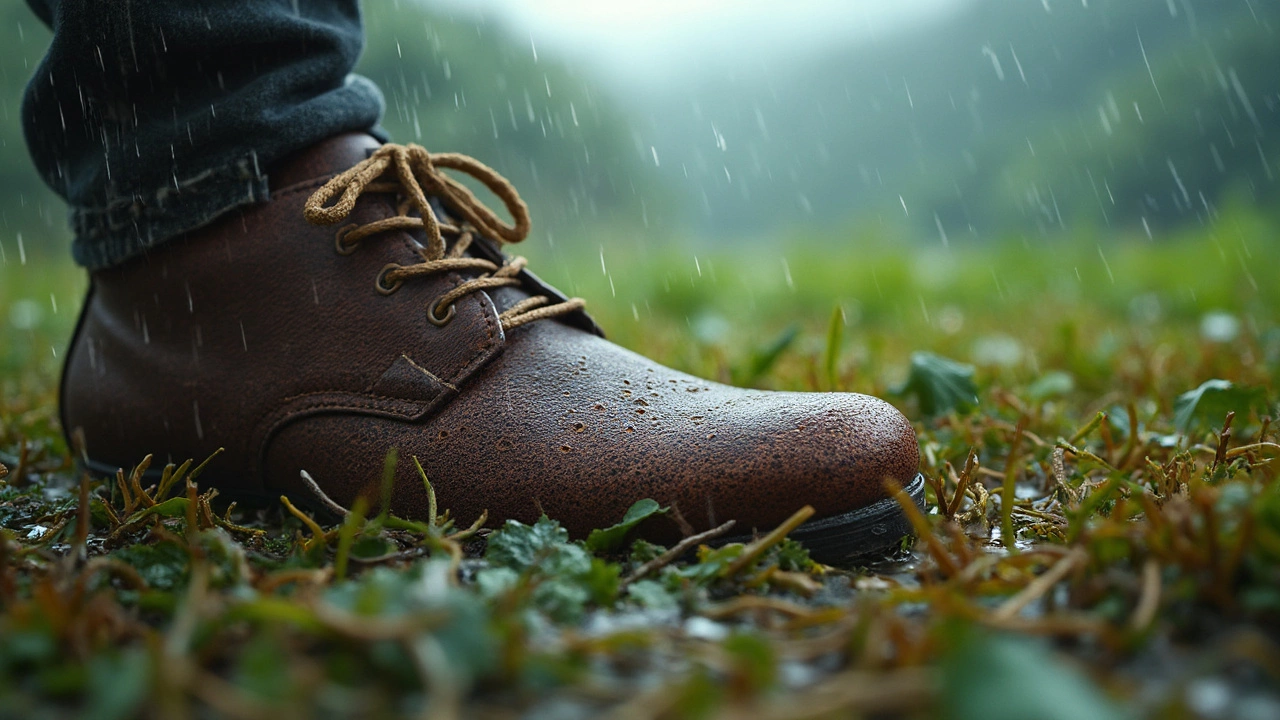Does Leather Get Tighter When Wet? Exploring the Science Behind It

Ever wondered why your leather shoes feel a little squishy after you've splashed through puddles? It turns out leather undergoes some interesting changes when it meets water. Let's get into what's happening with those fibers.
Leather, being a natural material, absorbs moisture quickly. This means when your leather shoes get wet, the fibers swell, potentially causing a snugger fit. Over time, as it dries, the leather can contract if not dried properly, leading it to shrink and feel even tighter.
But don't worry, it's not all doom and gloom for your treasured kicks. There are ways to manage the shrinking effect and keep your shoes in top shape. Through proper drying techniques and maintenance, you can enjoy your leather shoes without the fear of them pinching your toes.
- How Leather Reacts to Moisture
- Why Leather Shrinks When Wet
- Preventing Leather from Shrinking
- Caring for Wet Leather Shoes
How Leather Reacts to Moisture
Wondering why your leather shoes have a love-hate relationship with water? They're not alone. Leather has its quirks when it comes to reacting with moisture. Essentially, it's all about how the material's structure changes.
When leather gets wet, the water causes its fibers to swell. This might make your shoes feel a bit more snug. The tricky part? Leather is prone to retaining that moisture, which could lead to a long-term, tighter fit once it eventually dries — if not managed correctly.
The Nature of Leather Fibers
Leather is made from animal hide, which contains fibers that naturally want to bind together closely when exposed to moisture. This process isn't immediate, though. Several factors such as temperature, humidity, and the type of leather can affect how quickly or severely the shrinkage happens. So, whether it's that fancy full-grain pair or your trusty nubuck sneakers, each will react a bit differently to moisture.
Moisture and Leather Types
Different types of leather react uniquely. Here's a quick breakdown:
- Full-grain leather: Known for its durability, it handles moisture better but might still experience slight tightness.
- Suede and Nubuck: More porous, these types absorb water quickly, meaning it might become quite snug if not dried properly.
- Patent leather: Less prone to shrinkage since it's coated, but still not a fan of getting wet.
Interestingly, a study showed that untreated leather can absorb up to 30% of its weight in water, affecting comfort and fit. Conditioning the leather can significantly reduce this absorption, so it's always worth applying protective treatments.
With this understanding of how leather and moisture mix, you're in a good spot to keep those shoes fitting just right!
Why Leather Shrinks When Wet
Wondering why your leather shoes feel tighter after getting soaked? The science behind it is pretty fascinating. Leather consists of a network of fibers, primarily made up of collagen. When leather encounters moisture, these fibers absorb water, causing them to expand.
As the leather dries, the water evaporates, and the fibers' size decreases. It's this contracting process that makes the leather feel tighter. But the catch is, if your leather isn't dried properly, it can lead to uneven shrinkage and a permanent size change.
What's Happening Inside the Fibers?
Collagen fibers in the leather are like a bunch of tiny rubber bands. When water enters, these bands stretch. The problem arises when they dry and clump back together, not always returning to their original shape. This can be exacerbated if leather dries quickly, say, under direct heat or sunlight, leading to a stiffer and tighter fit.
Impact of Heat and Humidity
Heat accelerates the drying process, but not in a good way. Quick drying means the fibers don't have time to settle back to their natural position, which makes them shrink more. Humidity plays another role—if the air is too dry or too moist, it affects how the leather dries.
Here's a handy approach to minimize shrinkage: Let your wet leather shoes dry at room temperature. Stuffing them with crumpled newspaper can absorb excess moisture and help retain their shape. Bonus tip: Avoid radiators or hairdryers—these speed up drying and lead to uneven shrinkage.

Preventing Leather from Shrinking
Preserving your favorite pair of leather shoes from the clutches of shrinkage is simpler than it sounds. Here’s how you can do it effectively.
Drying the Right Way
When your leather shoes inevitably get wet, the way you dry them plays a crucial role in preventing shrinkage. Air drying at room temperature is your best bet. Avoid high heat like radiators or hairdryers, as these can cause the leather to contract faster. Instead, stuff your shoes with newspaper to help them maintain their shape and absorb moisture simultaneously.
Regular Conditioning
Keep your leather in prime condition by applying a good leather conditioner once every few weeks. This keeps the leather supple and resistant to water. When the leather is well-moisturized, it's less likely to become brittle and shrink. Think of it like a moisturizer for your shoes.
Waterproofing is Key
Prevention is always better than cure. Regularly applying a waterproof spray can protect your shoes from absorbing too much water in the first place. This is especially useful if you're frequently caught in the rain or walking through damp terrain.
Rotating Your Shoes
Sounds simple, right? But it's incredibly effective. Rotate between multiple pairs of shoes to prevent wearing the same pair every day. This gives each pair a chance to breathe and lets the moisture fully evaporate without causing any distortion in shape.
By following these straightforward steps, your leather shoes will stay comfy and stylish far longer, even when faced with the unexpected downpour!
Caring for Wet Leather Shoes
So, you've braved the rain, and now your leather shoes are soaked. Don't panic! With a bit of care, you can keep them looking sharp. The trick? Proper drying and conditioning. Let's break it down.
1. Start with Drying
First, gently pat your shoes with a soft cloth to remove excess water—don’t rub, as this can damage the leather. Stuff the shoes with newspaper to help them keep their shape and slowly absorb moisture from the inside.
Place the shoes in a well-ventilated area, avoiding direct heat sources like radiators and hairdryers. High heat can cause leather to dry out and crack.
As leather expert John Herman says, "Direct heat is the enemy of leather—always let them air dry naturally."
2. Condition Once Dry
Once your wet leather shoes are dry, it's time to condition them. Leather is like our skin; it needs moisture to keep from drying out. Use a quality leather conditioner to restore suppleness. Apply it in a circular motion with a soft cloth, reaching every nook and cranny.
3. Regular Maintenance
Regular care prevents future water damage. Consider using a waterproof spray specifically for leather. This creates a barrier against moisture, ideal for those drizzly days.
- Clean your shoes regularly to remove dirt and salt.
- Store them in a cool, dry place.
- Use shoe trees to help maintain their shape.
If your favorite leather shoes have survived several rainy seasons, it might be worth professional cleaning and conditioning by a cobbler. This can extend their life and your enjoyment.
Remember, a little care goes a long way in keeping those beloved kicks looking new.
- Mar, 26 2025
- Violet Greenfield
- 0
- Permalink
Written by Violet Greenfield
View all posts by: Violet Greenfield